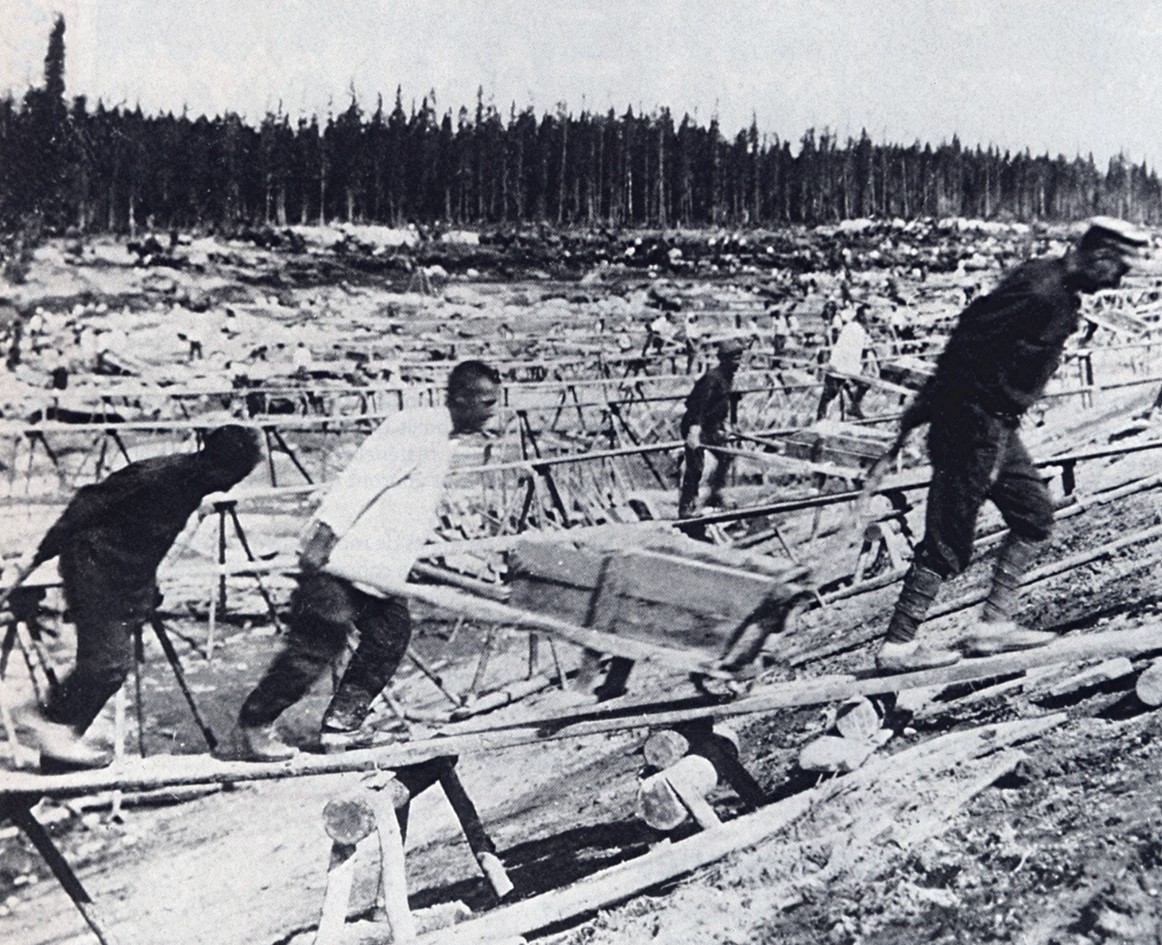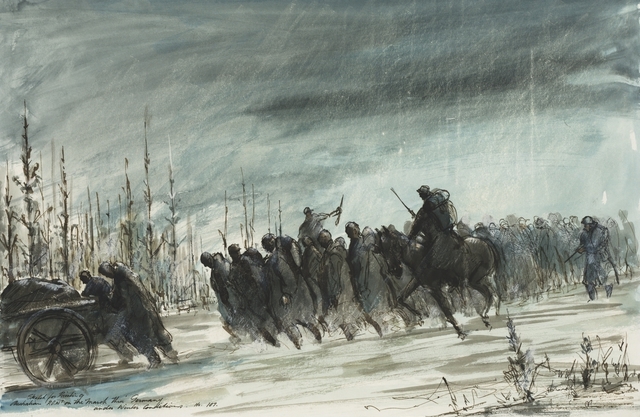|
Camp Fünfeichen
Camp Fünfeichen () was a World War II German prisoner-of-war camp located in Fünfeichen, a former estate within the city limits of Neubrandenburg, Mecklenburg, northern Germany. Built as Stalag II-A Neubrandenburg in 1939, it was extended by the officer camp Oflag II-E in 1940 (renamed Oflag-67, 1944). After the Soviet takeover in 1945 until 1949 it was used as special camp, NKVD-camp Nr. 9 of the Soviet secret service (NKVD). Today, the site of the camp is a memorial. Stalag II-A The camp was built in September 1939 to house Polish prisoners from the German September 1939 offensive. The first POWs arrived on 12 September. Some were used for completing the camp construction while housed in tents during the winter. Others were sent to work on farms. From May/June 1940 Dutch and Belgian prisoners arrived from the Battle of France, followed by French. A number of the French were from African colonial regiments and were used for the worst work such as collecting trash. A n ... [...More Info...] [...Related Items...] OR: [Wikipedia] [Google] [Baidu] |
Neubrandenburg
Neubrandenburg (, Low German ''Niegenbramborg'', both lit. ''New Brandenburg an der Havel, Brandenburg'') is a city in the southeast of Mecklenburg-Vorpommern, Germany. It is located on the shore of a lake called Tollensesee and forms the urban centre of the Mecklenburg Lake District, Mecklenburg Lakeland. The city is famous for its rich medieval heritage of Brick Gothic architecture, including the world's best preserved defensive wall of this style as well as a Marienkirche, Neubrandenburg, Concert Church (Saint Mary), the home venue of the Neubrandenburg Philharmonic. It is part of the European Route of Brick Gothic, a route which leads through seven countries along the Baltic Sea coast. Neubrandenburg is nicknamed for its four medieval city gates - ''Stadt der Vier Tore'' ("City of Four Gates"). Since 2011, Neubrandenburg has been the capital of the Mecklenburgische Seenplatte (district), Mecklenburgische Seenplatte district. It is the List of cities in Mecklenburg-Vorpommern, ... [...More Info...] [...Related Items...] OR: [Wikipedia] [Google] [Baidu] |
Teterow
Teterow () is a town of Germany, in the Rostock (district), district of Rostock, in Mecklenburg-Western Pomerania. It is the geographical center of this federal state. It had a population of 8,852 in 2011. History The ''Stadtkirche St. Peter und Paul'' (St. Peter and St. Paul's Church), was built in 1215 in Late Romanesque architecture, Romanesque and gothic architecture, Gothic style. There are two remaining gates of the ancient city wall: the 14th-century ''Malchiner Tor'' (today the seat of the museum of local history), and the ''Rostocker Tor''. The ''Marktplatz'' (Market Square), with the Town Hall, was built in 1910 in Baroque Revival architecture, Neo-Baroque style. The "Hechtbrunen" with inscription in "Plattdütsch" (Northgerman dialect). Weck Lüd sünd klauk un weck sünd däsig, un weck dei sünd wat öwernäsig. Lat't ehr spijöken, kinnings lat't, dei Klock hett lürr't, dei Hekt is fat't. Culture ''Thusch'' - - Theater in der Uhrenschule (Theatre at the Cloc ... [...More Info...] [...Related Items...] OR: [Wikipedia] [Google] [Baidu] |
Labor Camp
A labor camp (or labour camp, see British and American spelling differences, spelling differences) or work camp is a detention facility where inmates are unfree labour, forced to engage in penal labor as a form of punishment. Labor camps have many common aspects with slavery and with prisons (especially prison farms). Conditions at labor camps vary widely depending on the operators. Convention no. 105 of the United Nations International Labour Organization (ILO), adopted internationally on 27 June 1957, intended to abolish camps of forced labor. In the 20th century, a new category of labor camps developed for the imprisonment of millions of people who were not criminals ''per se'', but political opponents (real or imagined) and various so-called undesirables under communist and fascist regimes. Precursors Early-modern states could exploit convicts by combining prison and useful work in manning their galleys. This became the sentence of many Christian captives in the Ottoman ... [...More Info...] [...Related Items...] OR: [Wikipedia] [Google] [Baidu] |
Gaston Antoine
Gaston is a masculine given name of French origin and a surname. The name "Gaston" may refer to: People First name * Gaston I, Count of Foix (1287–1315) * Gaston II, Count of Foix (1308–1343) * Gaston III, Count of Foix (1331–1391) * Gaston IV, Count of Foix (1422–1472) * Gaston I, Viscount of Béarn (died circa 980) * Gaston II, Viscount of Béarn (circa 951 – 1012) * Gaston III, Viscount of Béarn (died on or before 1045) * Gaston IV, Viscount of Béarn (died 1131) * Gaston V, Viscount of Béarn (died 1170) * Gaston VI, Viscount of Béarn (1173–1214) * Gaston VII, Viscount of Béarn (1225–1290) * Gaston of Foix, Prince of Viana (1444–1470) * Gaston, Count of Marsan (1721–1743) *Gaston, Duke of Orléans (1608–1660), French nobleman *Gastón Acurio (born 1967), Peruvian chef * Gaston Bachelard (1884–1962), French philosopher * Gaston Balande (1880–1971), French painter and illustrator * Gaston Borch (1871–1926), French composer, arranger, conductor, cell ... [...More Info...] [...Related Items...] OR: [Wikipedia] [Google] [Baidu] |
Red Army
The Workers' and Peasants' Red Army, often shortened to the Red Army, was the army and air force of the Russian Soviet Republic and, from 1922, the Soviet Union. The army was established in January 1918 by a decree of the Council of People's Commissars to oppose the military forces of the new nation's adversaries during the Russian Civil War, especially the various groups collectively known as the White Army. In February 1946, the Red Army (which embodied the main component of the Soviet Armed Forces alongside the Soviet Navy) was renamed the "Soviet Army". Following the dissolution of the Soviet Union it was split between the post-Soviet states, with its bulk becoming the Russian Ground Forces, commonly considered to be the successor of the Soviet Army. The Red Army provided the largest land warfare, ground force in the Allies of World War II, Allied victory in the European theatre of World War II, and its Soviet invasion of Manchuria, invasion of Manchuria assisted the un ... [...More Info...] [...Related Items...] OR: [Wikipedia] [Google] [Baidu] |
The March (1945)
"The March" refers to a series of forced marches during the final stages of the Second World War in Europe. From a total of 257,000 western Allied prisoners of war held in German military prison camps, over 80,000 POWs were forced to march westward across Poland, Czechoslovakia, and Germany in extreme winter conditions, over about four months between January and April 1945. This series of events has been called various names: "The Great March West", "The Long March", "The Long Walk", "The Long Trek", "The Black March", "The Bread March", and "Death March Across Germany", but most survivors just called it "The March". As the Soviet Army was advancing on the Eastern front, German authorities decided to evacuate POW camps, to delay liberation of the prisoners. At the same time, hundreds of thousands of German civilian refugees, most of them women and children, as well as civilians of other nationalities, were also making their way westward on foot. Notorious examples include: *f ... [...More Info...] [...Related Items...] OR: [Wikipedia] [Google] [Baidu] |
Arbeitslager
''Arbeitslager'' () is a German language word which means labor camp. Under Nazism, the German government (and its private-sector, Axis, and collaborator partners) used forced labor extensively, starting in the 1930s but most especially during World War II. Another term was ''Zwangsarbeitslager'' ("forced labor camp"). The Nazis operated several categories of ''Arbeitslager'' for different categories of inmates. The largest number of them held civilians forcibly abducted in the occupied countries (see Łapanka for Polish context) to provide labour in the German war industry, repair bombed railroads and bridges, or work on farms and in stone quarries. The Nazis also operated concentration camps, some of which provided free forced labor for industrial and other jobs while others existed purely for the extermination of their inmates. A notable example is Mittelbau-Dora labor camp complex that serviced the production of the V-2 rocket. See List of German concentration camps ... [...More Info...] [...Related Items...] OR: [Wikipedia] [Google] [Baidu] |
Battle Of Hurtgen Forest
A battle is an occurrence of combat in warfare between opposing military units of any number or size. A war usually consists of multiple battles. In general, a battle is a military engagement that is well defined in duration, area, and force commitment. An engagement with only limited commitment between the forces and without decisive results is sometimes called a skirmish. The word "battle" can also be used infrequently to refer to an entire operational campaign, although this usage greatly diverges from its conventional or customary meaning. Generally, the word "battle" is used for such campaigns if referring to a protracted combat encounter in which either one or both of the combatants had the same methods, resources, and strategic objectives throughout the encounter. Some prominent examples of this would be the Battle of the Atlantic, Battle of Britain, and the Battle of France, all in World War II. Wars and military campaigns are guided by military strategy, whereas batt ... [...More Info...] [...Related Items...] OR: [Wikipedia] [Google] [Baidu] |
Armistice With Italy
The Armistice of Cassibile ( Italian: ''Armistizio di Cassibile'') was an armistice that was signed on 3 September 1943 by Italy and the Allies, marking the end of hostilities between Italy and the Allies during World War II. It was made public five days later. It was signed on September 3rd by Major-General Walter Bedell Smith for the Allies and Brigade-General Giuseppe Castellano for Italy. The armistice's signing took place at a summit in an Allied military camp at Cassibile, Sicily, which had recently been occupied by the Allies. The armistice was approved by both Victor Emmanuel III and Marshal Pietro Badoglio, who was serving as Prime Minister of Italy at the time. The signing of the armistice was kept secret on that day, and was announced to the media on September 8th. Nazi Germany responded by attacking Italian forces in Italy, southern France and the Balkans, and freeing Benito Mussolini on 12 September. The Italian forces were forcefully disbanded in the north an ... [...More Info...] [...Related Items...] OR: [Wikipedia] [Google] [Baidu] |
Italy
Italy, officially the Italian Republic, is a country in Southern Europe, Southern and Western Europe, Western Europe. It consists of Italian Peninsula, a peninsula that extends into the Mediterranean Sea, with the Alps on its northern land border, as well as List of islands of Italy, nearly 800 islands, notably Sicily and Sardinia. Italy shares land borders with France to the west; Switzerland and Austria to the north; Slovenia to the east; and the two enclaves of Vatican City and San Marino. It is the List of European countries by area, tenth-largest country in Europe by area, covering , and the third-most populous member state of the European Union, with nearly 59 million inhabitants. Italy's capital and List of cities in Italy, largest city is Rome; other major cities include Milan, Naples, Turin, Palermo, Bologna, Florence, Genoa, and Venice. The history of Italy goes back to numerous List of ancient peoples of Italy, Italic peoples—notably including the ancient Romans, ... [...More Info...] [...Related Items...] OR: [Wikipedia] [Google] [Baidu] |






